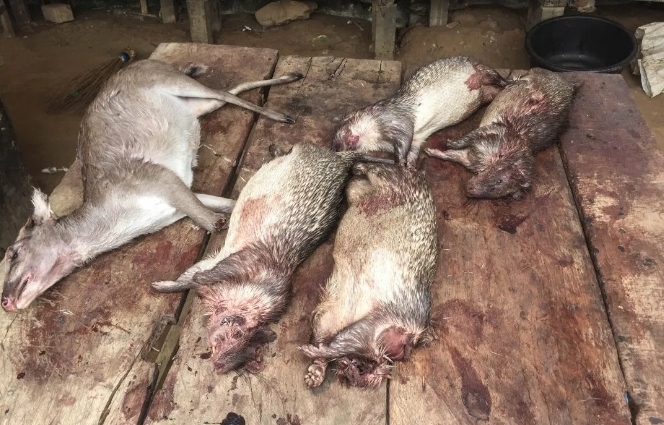Tech giant Facebook on the average attracts about 2.89billion active subscribers who every minute upload hundreds of thousands of statuses, comments and discuss a plethora of subjects that could range from lifestyle to extremist views to the sales of endangered species across continents.
Social media platforms have provided a convenient leverage on which both legal and illegal wildlife traders connect and transact business as never before. While some operate legally within the confines of international laws, others use private chats and groups to bypass middlemen and exchange information on how to evade law enforcement. Both private and public channels alike are used on social media platforms to sell wildlife as pets or luxury artefacts. Traders connect with a vast global customer base via public posts, however arrangements regarding payment, shipping and conversations about other available wildlife can be quickly carried out through private messaging services.
Some social media platforms have adopted strong community regulations that ban any attempt to sell or by endangered wildlife and private sales of live animals. Nevertheless it takes only a few seconds of searching to find posts featuring sales of endangered animals captured from the wild for export in wholesale quantities, which is in clear violation of international laws.
Combating this is of the essence as wildlife trade poses a great threat to global biodiversity and could contribute to the spread of infectious zoonotic diseases.
The journal Conservation Biology recently published a study where the online behaviour of wildlife traders based in West Africa was examined and also an exploration of how researchers and moderators can use information scattered across different parts of social media platforms to detect posts selling wild birds.
Some of the trade studied are allowed under international trade agreements. However its scale and extent of the trade is a source of concern to conservationist. The trade in wild parrots from West Africa has traced to the global spread of infectious diseases.
Data analysis gathered from the study while working with ornithologists, conservationists, and legal analysts revealed about 80 different species in trade some of which are highly threatened and prohibited from commercial trade under international laws. Those species ranged from parrots and hornbills to song birds and doves.
There were about 400 social media posts made by known bird traders featuring birds in trade.
Majority of the posts did not contain clear messages that could be used to ascertain whether the posts were aimed at the sale of wildlife, violating platform community standards.
The application of simple algorithms searching for keywords such as “for sale”, or the names of target species, would help detect some of this activity. But administration in some closed Facebook groups have advised their members to avoid using certain key word algorithms.
The research further found that the triangulation of information available elsewhere both within and beyond social media platforms could be used to make strong inferences about how posts facilitate trade, violate platform standards and signpost illicit activity. Such information may be found in elements such as images, profile pictures or comments. Thus it is necessary that e parts are involved in monitoring social media for potentially illegal trade, they have the knowledge in identifying the species involved and contextualising the activity within international and domestic regulations.
There is no standard procedure for detecting wildlife trade online as different wildlife are bought and sold in different locations online and in different ways let alone illicit or harmful trade.
The study, however, establishes a framework for thinking about how different sectors of illicit or harmful activity can be understood and monitored and moderated more effectively. Careful analyses led by experts in specific fields can help in the design of algorithms and approaches to moderation tailored to the situation.
It is noteworthy that new regulatory legislation is being planned or coming into play in major economies including China, the US, the EU, Australia and the UK, aimed at cajoling and coercing big tech to do more to protect users from harmful content.
Carefully designed algorithms that can intelligently triangulate across multiple data sources will be part of the solution. Manual analysis will also be critical. Knowing which species were in trade and the relevant local legislation is critical for understanding legality.
But such tasks are beyond the abilities of artificial intelligence and machine learning.
However collaborations between tech firms and subject matter experts remain in their infancy.



















Right now it seems like BlogEngine is the preferred blogging platform available right now.
(from what I’ve read) Is that what you are using on your blog?
An impressive share! I have just forwarded this onto a co-worker who was doing a little homework on this.
And he actually bought me dinner simply because I discovered
it for him… lol. So let me reword this…. Thanks for the meal!!
But yeah, thanks for spending time to discuss
this issue here on your web page.
Highly energetic blog, I enjoyed that a lot. Will there
be a part 2?
There’s definately a lot to know about this subject. I
really like all the points you have made.
I think other web site proprietors should take this website as an model, very clean and magnificent user friendly style and
design, let alone the content. You are an expert in this topic!
I was just looking for this info for some time.
After six hours of continuous Googleing, at last I got it
in your site. I wonder what’s the lack of Google strategy that
don’t rank this type of informative websites in top of the list.
Normally the top websites are full of garbage.
This is very interesting, You’re a very skilled blogger.
I have joined your feed and look forward to seeking more of your
excellent post. Also, I’ve shared your website in my social
networks!
I constantly spent my half an hour to read this blog’s articles all the time along with a cup
of coffee.
Hi there, its fastidious post concerning media print, we all be familiar with media is a impressive source of information.
WOW just what I was looking for. Came here by searching for cute web cam
girls
Valuable information. Fortunate me I found your site accidentally, and I’m
surprised why this coincidence didn’t came about earlier!
I bookmarked it.
Howdy! This is kind of off topic but I need some guidance from an established blog.
Is it hard to set up your own blog? I’m not very techincal but I can figure things out pretty
fast. I’m thinking about setting up my own but I’m not sure where to begin. Do you have any tips
or suggestions? Appreciate it
Excellent weblog here! Also your web site rather a lot up very fast!
What web host are you the usage of? Can I am getting your associate link
on your host? I desire my website loaded up as fast
as yours lol